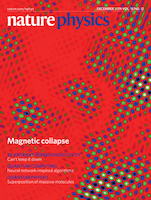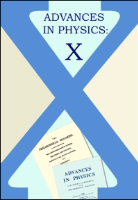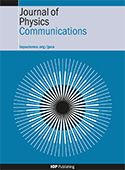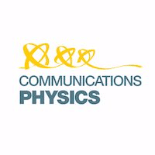
JOURNAL OF THE KOREAN PHYSICAL SOCIETY
Scope & Guideline
Connecting Innovators in Physical Science
Introduction
Aims and Scopes
- Condensed Matter Physics:
Research in this area includes studies on the electronic, magnetic, and optical properties of materials, particularly nanomaterials and complex systems. - Quantum Physics and Information:
The journal explores quantum mechanics and its applications, including quantum computing, quantum entanglement, and quantum optics, emphasizing both theoretical frameworks and experimental implementations. - Plasma Physics and Fusion Technology:
This scope covers research on plasma behavior, magnetohydrodynamics, and innovative technologies for fusion energy, including diagnostics and modeling of plasma confinement. - Medical Physics and Radiation Technology:
Focusing on the application of physics in medicine, this area includes studies on radiation therapy, imaging technologies, and dosimetry methods for clinical applications. - Nanotechnology and Materials Science:
Research related to the synthesis, characterization, and application of nanomaterials, including their electronic, optical, and mechanical properties. - Astrophysics and Cosmology:
This area involves theoretical and experimental studies related to cosmic phenomena, dark matter, and high-energy astrophysics. - Optics and Photonics:
Research in this field includes the study of light-matter interactions, laser physics, and the development of optical devices and technologies.
Trending and Emerging
- Machine Learning and Artificial Intelligence Applications in Physics:
There is a growing trend of utilizing machine learning techniques to enhance data analysis in experimental physics, improve predictive models, and optimize experimental setups. - Quantum Technologies and Quantum Computing:
Research in quantum technologies, especially in quantum computing and quantum communication, is rapidly expanding, reflecting interest in harnessing quantum mechanics for practical applications. - Advanced Materials and Nanostructures:
Emerging research focuses on the synthesis and application of advanced materials, particularly nanostructured materials with novel properties for electronics, photonics, and energy applications. - Biophysics and Medical Applications:
The intersection of physics and biology is increasingly significant, with studies exploring the physical principles underlying biological processes and the development of medical technologies. - Sustainable Energy Technologies:
Research on renewable energy sources, energy storage systems, and materials for energy efficiency has gained momentum, reflecting global efforts towards sustainability. - Plasma-Based Technologies:
Emerging research in plasma physics, particularly in applications for materials processing and energy generation, is on the rise, highlighting the versatility of plasma in technological advancements.
Declining or Waning
- Classical Mechanics:
Research related to classical mechanics has seen a decline as newer methodologies and technologies in quantum mechanics and statistical physics gain prominence. - Traditional Materials Science:
While materials science remains a core area, traditional studies focusing solely on bulk properties without considering nanoscale effects or innovative materials have become less frequent. - Nonlinear Dynamics in Simple Systems:
Research focusing on nonlinear dynamics in basic systems has decreased, likely overshadowed by more complex and interdisciplinary approaches that incorporate nonlinear dynamics in diverse applications. - Theoretical Astrophysics:
Theoretical studies in astrophysics that do not incorporate observational data or experimental validation have diminished as the field moves towards more empirical and data-driven approaches.
Similar Journals

Nature Physics
Transforming Theoretical Insights into Practical ApplicationsNature Physics is a premier journal dedicated to publishing high-impact research in the realm of physics, brought to you by the esteemed NATURE PORTFOLIO. With its ISSN 1745-2473 and E-ISSN 1745-2481, this journal has established itself as a vital resource for the physics community, enjoying a remarkable Q1 quartile ranking in the Physics and Astronomy category for 2023 and securing an impressive Rank #5/243 and a 98th percentile ranking in Scopus. Since its inception in 2005, Nature Physics has become a catalyst for innovation, featuring cutting-edge research that encompasses a broad spectrum of physics disciplines. Although it operates under traditional subscription models, it maintains a commitment to accessibility through selective publications and editorial excellence. Positioned in Berlin, Germany, this journal is a must-read for researchers, professionals, and students who seek to stay at the forefront of advancements in physics.

Bulletin of the Lebedev Physics Institute
Cultivating academic growth through rigorous research.Bulletin of the Lebedev Physics Institute is a peer-reviewed journal dedicated to advancing the field of physics and astronomy, published by PLEIADES PUBLISHING INC. With a print ISSN of 1068-3356 and an e-ISSN of 1934-838X, this journal has been an essential platform for disseminating significant research findings since its inception in 2009. It continues to provide insight into various areas of general physics and astronomy, and consistently aims to foster innovative discussions among researchers and scholars. Although currently positioned in the Q4 category within the 2023 Scopus rankings, it serves a vital role in linking emerging trends with established research, catering to a global audience seeking to explore complex concepts within the field. By contributing to the body of knowledge, the Bulletin supports academic growth and collaboration across diverse sectors. Despite its challenges in ranking, the journal’s unique perspectives and ongoing publications underscore its commitment to pushing the boundaries of scientific inquiry in the United States and beyond.

Romanian Journal of Physics
Exploring the universe through rigorous research.Welcome to the Romanian Journal of Physics, a distinguished platform dedicated to advancing the field of physics and astronomy since its inception. Published by EDITURA ACAD ROMANE, this journal plays a pivotal role in disseminating high-quality research from Romania and around the globe, with an impressive impact factor that reflects its rigorous academic standards. With a focus on a broad range of topics in general physics and astronomy, it proudly maintains a Q2 ranking in its category for 2023, positioning itself among the top journals in the field. The journal, which has been converging valuable research contributions from 2008 until 2024, is accessible to a wide audience of researchers, professionals, and students interested in the latest developments and discoveries in physics. While it operates under a traditional publication model without Open Access, its commitment to quality research ensures that the contributions featured in its pages resonate well within the scientific community. We invite you to explore the rich findings published in the Romanian Journal of Physics and to engage with the vital discussions shaping the future of physics.

Advances in Physics-X
Empowering Knowledge through Open AccessAdvances in Physics-X is a premier open-access journal published by Taylor & Francis Ltd, dedicated to advancing the frontiers of knowledge in the field of Physics and Astronomy. Since its inception in 2016, the journal has established itself as a vital platform for researchers and professionals, showcasing innovative research and cutting-edge theories that influence a broad array of sub-disciplines within physics. With an impressive impact factor and ranked in the 94th percentile among its peers, it resides in the Q1 category for Physics and Astronomy (miscellaneous), indicating its significant contributions to the academic community. Located in the United Kingdom, the journal encourages open access to foster wider dissemination and visibility of scholarly works, aligning with contemporary academic trends that prioritize global knowledge sharing. The ongoing commitment to publishing high-quality research ensures that Advances in Physics-X remains an essential resource for students, industry experts, and academics alike, helping to shape the future of physics research through collaboration and innovation.

Journal of Physics Communications
Bridging Theory and Application in PhysicsJournal of Physics Communications, published by IOP Publishing Ltd, serves as a significant platform for the dissemination of innovative research in the realm of physics and astronomy. Since its inception in 2017, this Open Access journal has fostered a collaborative environment, allowing researchers, professionals, and students to share their findings and ideas without barriers. With an ISSN of 2399-6528, the journal has established its credibility in the academic community, achieving a ranking of Q3 in the 2023 category of Physics and Astronomy (miscellaneous), as well as a respectable position in Scopus with a rank of #122 out of 243 in its field. The journal's focus is on bridging theoretical concepts and practical applications, making it an essential resource for those engaged in the evolving landscape of physics. The Journal of Physics Communications not only aims to advance knowledge but also to inspire interdisciplinary collaboration, inviting contributions from diverse areas within physics. Authors and readers alike will find this journal particularly beneficial to stay updated on emerging trends and innovative research.

Communications Physics
Fostering dialogue among the brightest minds in physics.Communications Physics is a premier open access journal published by Nature Portfolio, dedicated to disseminating high-quality research in the field of Physics and Astronomy. Since its inception in 2018, the journal has rapidly established itself as a vital platform for innovative scientific communication, boasting an impressive Impact Factor and achieving Q1 status in the 2023 category of Physics and Astronomy (miscellaneous). With a Scopus rank of #31 out of 243, placing it within the 87th percentile, Communications Physics attracts a global audience of researchers, professionals, and students eager to engage with cutting-edge findings. The journal supports open access, ensuring that research is freely available to the public, which enhances its visibility and encourages broader discussions within the scientific community. Located in Berlin, Germany, Communications Physics aims to bridge the gap between various disciplines within physics, fostering interdisciplinary collaboration and inspiring future research endeavors.

BRAZILIAN JOURNAL OF PHYSICS
Fostering Collaboration in Global PhysicsBRAZILIAN JOURNAL OF PHYSICS, published by SPRINGER, is a prominent platform dedicated to the dissemination of research within the realm of physics and astronomy. With an ISSN of 0103-9733 and E-ISSN of 1678-4448, this esteemed journal has been contributing to the field since its inception in 1996, and it continues to be pivotal in showcasing innovative studies and breakthroughs. The journal is categorized in the Q4 quartile for the year 2023, reflecting a dedicated focus on advancing knowledge across a variety of disciplines, particularly in general physics and astronomy, where it ranks 126th out of 243 in Scopus rankings. Although it currently does not operate under an open-access model, it remains an invaluable resource for researchers, professionals, and students eager to enhance their understanding of complex physical principles and developments. The journal is committed to promoting high-quality research, bridging gaps in knowledge, and fostering collaboration within the global physics community.

CHINESE PHYSICS LETTERS
Connecting Theory and Experiment in PhysicsChinese Physics Letters is a prestigious journal published by IOP Publishing Ltd, based in the United Kingdom. Since its inception in 1984, the journal has served as a vital platform for disseminating impactful research in the field of physics, achieving a noteworthy Q1 ranking in the category of Physics and Astronomy (miscellaneous) as of 2023. Renowned for its rapid publication process, this journal is dedicated to providing a forum for high-quality, concise articles that address innovative theoretical and experimental findings relevant to both the academic community and industry practitioners. With an impressive Scopus rank of #52 out of 243, placing it in the 78th percentile, Chinese Physics Letters continues to influence the global physics landscape. Researchers, professionals, and students alike find this journal indispensable for staying abreast of the latest developments and trends in physics.

PHYSICAL REVIEW LETTERS
Delivering Swift Insights into Fundamental ResearchPhysical Review Letters, published by the American Physical Society, is a premier journal in the field of Physics and Astronomy renowned for its rapid dissemination of high-impact research findings. With a distinguished history dating back to 1958 and an impressive ranking of #13 out of 243 in the general physics category, it stands proudly within the Q1 quartile, placing it in the top 6% of journals in its field. The journal focuses on brief reports of significant fundamental research across all areas of physics, making it an essential resource for researchers, professionals, and students seeking to stay at the forefront of developments in their field. Although Physical Review Letters does not offer open access options, its rigorous peer-review process ensures a high standard of quality and relevance in its published articles. With an unwavering commitment to advancing the understanding of physical science, this journal is indispensable for those looking to make a genuine impact in their research endeavors.

Jurnal Fizik Malaysia
Empowering Researchers to Illuminate the World of Physics.Jurnal Fizik Malaysia is a prominent academic journal dedicated to advancing the field of physics, published by the esteemed Institut Fizik Malaysia. With an aim to foster knowledge dissemination and research collaboration among physicists, the journal serves as a vital platform for original research articles, reviews, and technical notes that cover various sub-disciplines of physics. Although the journal operates under a traditional subscription model, its commitment to quality has been bolstered by a rigorous peer-review process, ensuring high academic standards. Researchers and students in Malaysia and beyond are encouraged to engage with this journal, contributing to a deeper understanding of physical sciences and its applications. Moreover, with its ISSN 0128-0333, Jurnal Fizik Malaysia continues to play a significant role in the scientific community, enhancing visibility and accessibility for local and international research outputs in the ever-evolving landscape of physics.